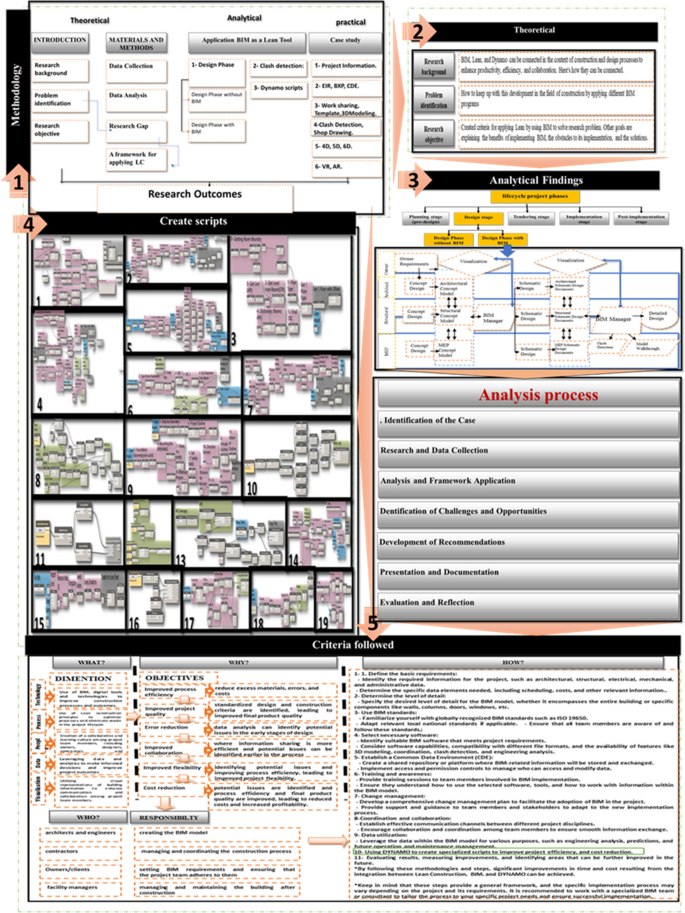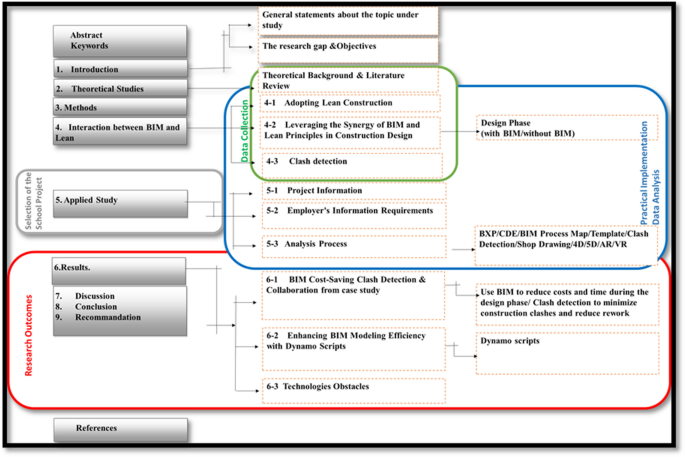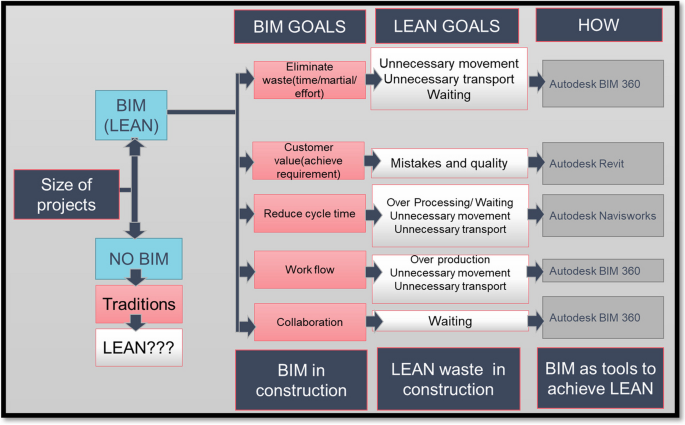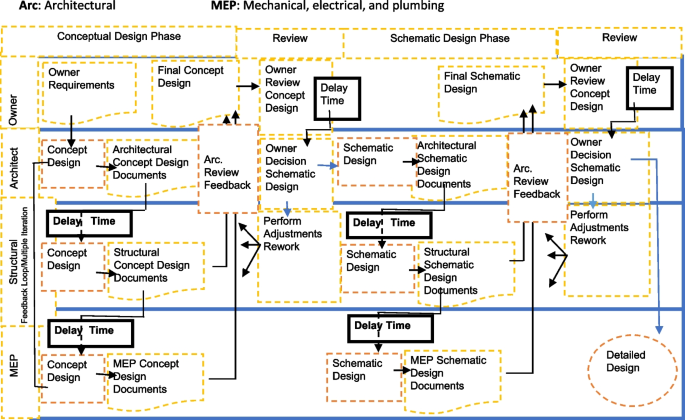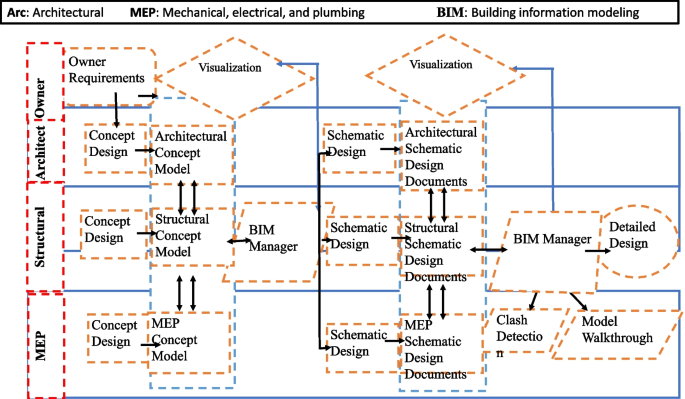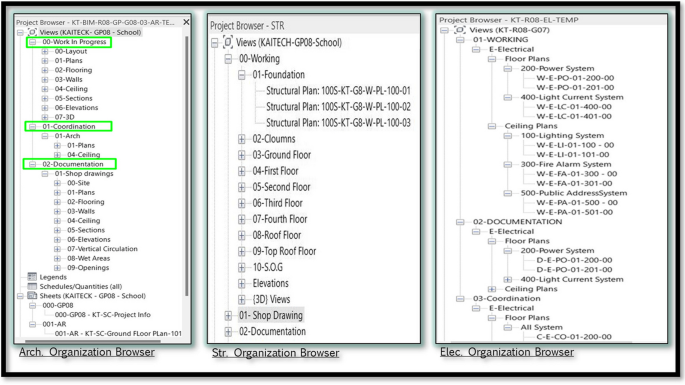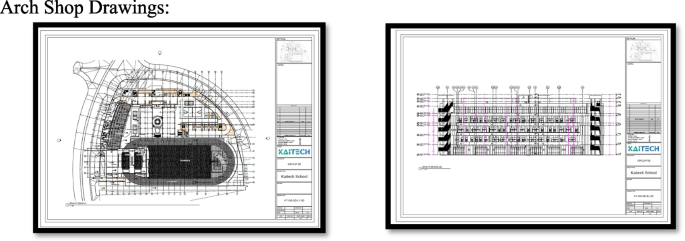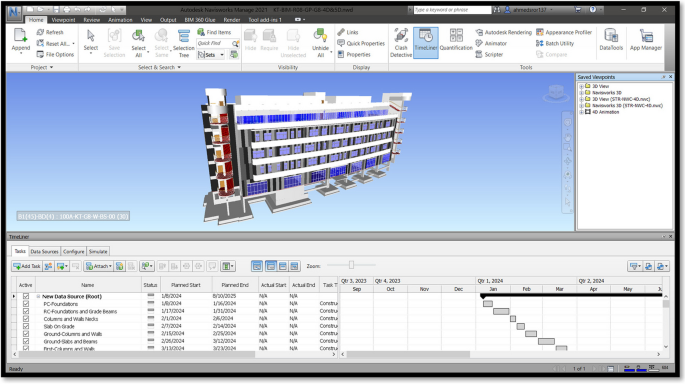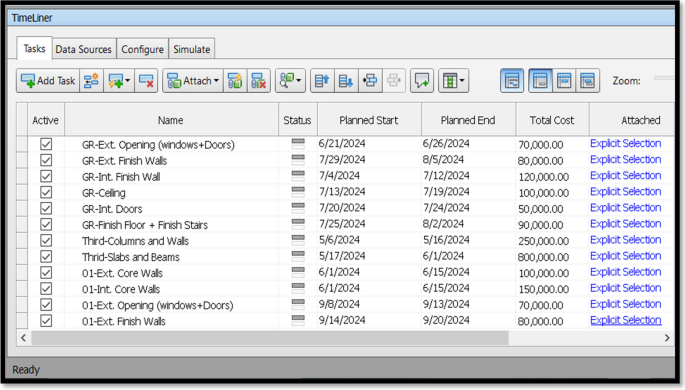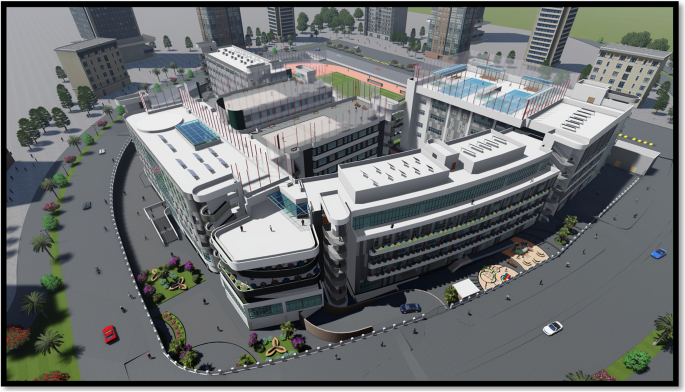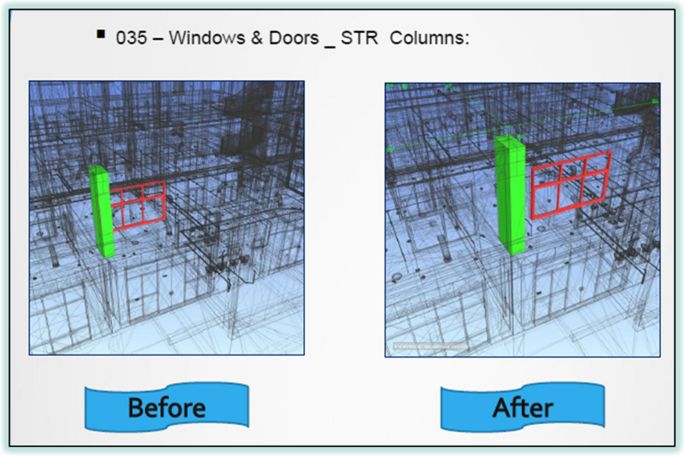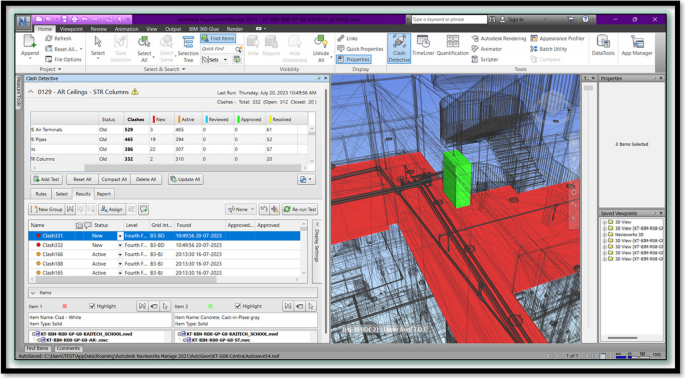- Research
- Open access
- Published:
The role of BIM as a lean tool in design phase
Journal of Engineering and Applied Science volume 71, Article number: 23 (2024)
Abstract
In the architectural, engineering, and construction industry, poor visualization of construction processes and lack of information exchange between different work teams can lead to poor performance. To address these challenges, lean construction methodologies aim to reduce and eliminate waste in construction processes, while BIM technology aims to enhance collaboration between project team members. In general, these technologies can be used together to improve project management and cost reduction. This can be achieved through improving workflow and coordination, enhancing interaction among project members, and using available tools to analyze and improve work. Many aspects of the integration between LC and BIM have been studied, and researchers have come up with some findings and recommendations. Most studies previously demonstrated theoretically that cost reductions using BIM techniques are significant compared to the traditional approach of project management. This is what this study proved practically by applying BIM in the design of a building which is quite successful in construction as it identifies the main causes of construction waste such as reducing waiting time and reducing non-value-added work by using Dynamo to develop these designs. So, the research problem comes, which is how to keep up with development in the field of construction by applying different BIM programs, which results in reducing the time and cost used in design. BIM is a technology that aims to enhance project management and cut costs. A digital representation of the project that contains all the data required for planning, managing, and carrying out the project is created using BIM.
Introduction
The field of architecture, engineering, and construction (AEC) development has seen significant advancements in recent years, although its progress may not be as noticeable as in other sectors. The construction industry, globally, has been characterized by low productivity, with value added per person growing at an average rate of only 1.0% between 1995 and 2015, compared to the overall economic growth rate of 2.7%. In comparison, the manufacturing sector experienced a growth rate of approximately 3.6% during the same period [1]. This productivity gap highlights the need for innovative approaches to improve efficiency and performance in the AEC industry.
One such approach is BIM, which offers numerous benefits to project teams. BIM enables enhanced information sharing and communication among stakeholders, leading to improved coordination and reduced errors. Additionally, BIM provides a visual representation of the construction process, facilitating better planning and communication among team members [2]. However, the full potential of BIM can be realized by incorporating LC principles, which optimize workflows and minimize waste, thereby enhancing overall project performance [3]. Various studies have emphasized the importance of implementing lean practices in the AEC industry [4,5,6]. These studies have explored the benefits of lean construction and addressed the challenges associated with its implementation [3]. Furthermore, some studies have examined both the advantages and obstacles and have provided recommendations for academics and professionals seeking to develop and implement lean practices [7,8,9].
Despite these efforts, there is still a research gap in understanding the criteria for effectively applying lean principles using BIM in the AEC industry. While previous studies have highlighted the benefits and challenges of implementing lean construction and BIM separately, there is a need to explore the integration of these two approaches to maximize their potential synergies. This study aims to fill this research gap by establishing criteria for the application of lean principles using BIM, addressing the research problem comprehensively. The main objective of this paper is to establish criteria for the application of BIM, as illustrated in Fig. 1, in order to address the research problem. In addition to this, the paper aims to explain the benefits of implementing BIM, identify the obstacles to its effective implementation, and propose solutions. By addressing these objectives, this study seeks to contribute to the existing body of knowledge on the integration of lean principles and BIM in the AEC industry.
Theoretical studies
The integration of BIM and LC principles technology has been a topic of interest in the AEC industry. Lean construction aims to improve project efficiency and reduce waste, while BIM facilitates collaborative decision-making and information sharing among project stakeholders. While individual studies have explored the benefits of lean construction and BIM separately, there is a research gap in understanding the potential synergies and benefits that can be achieved by integrating these two approaches.
Several previous studies have contributed to the existing body of knowledge in this field. Papers [1,2,3,4, 6, 9,10,11,12,13] provide valuable insights and lessons learned regarding the integration of lean and BIM in the construction industry. These studies highlight the positive impact of lean construction on project performance, such as workflow optimization and waste reduction, as well as the benefits of BIM in coordination, communication, clash detection, and construction efficiency. Challenges and benefits associated with the application of lean construction in construction are discussed in papers [5, 7], and [14]. These papers shed light on the obstacles that organizations may face when implementing lean construction principles and identify the potential benefits that can be realized through effective implementation.
The role of BIM in project planning and design is addressed in papers like [15], which highlight the capabilities of BIM in enhancing design and planning processes. Additionally, trust in BIM projects and a case study in Malaysia are explored in one paper [16], providing insights into the importance of trust and collaboration in BIM-enabled projects. In the context of software engineering challenges, a source [17] discusses the challenges associated with the use of BIM software in the construction industry. This paper provides valuable information on the software-related obstacles that practitioners may encounter when implementing BIM. Finally, one paper [18] focuses on the design of semantic data models in the construction industry, providing insights into the development of data models that can enhance information sharing and interoperability in BIM-enabled projects.
Methods
The integration of BIM and LC principles in the construction industry, particularly in the design phase, presents a promising approach to enhance project outcomes and improve efficiency. However, there is a need to investigate how these two methodologies can effectively interact and address the challenges associated with their integration. This study employed qualitative methods to explore the effective integration of BIM and LC in the design phase, with a focus on developing a framework for applying LC principles. To build a framework as shown in Fig. 2 for applying lean construction, three questions need to be answered are as follows:
-
Q1: How can BIM and lean interact effectively in the design phase?
-
Q2: What techniques are used to achieve BIM/lean interactions in the design phase?
-
Q3: What are the challenges to apply these?
To address these questions, the following methodology was followed:
The research began with an extensive literature review of relevant studies on BIM [15, 16, 19] and lean construction [5, 7, 14]. The review aimed to identify best practices for implementing BIM and LC. The literature review provided a theoretical foundation and insights into the potential benefits and challenges of integrating BIM and LC [11].
-
1.
Data collection: Relevant data and information were collected from previous studies and case studies that highlighted the potential benefits of integrating BIM and LC in the design phase. Data sources included academic journals and websites [17]. The timeframe for data collection spanned from February 2023 to September 2023. The selected data sources were critically reviewed, and the most pertinent information was extracted for further analysis.
-
2.
Selection of the school project: The selected project for this study was a school construction project. The choice of a school project was based on its size and the potential benefits of applying BIM. Given the large scale of the project, it required effective management of complexities and the utilization of BIM to enhance project outcomes. The study aimed to demonstrate the effectiveness of BIM in managing architectural, structural, and technical complexities and achieving efficiency and coordination across all aspects of the project.
-
3.
Practical implementation: The findings from the literature review were applied to the selected school construction project. BIM methodologies and lean principles were integrated into the design phase to optimize the design process, reduce waste, and enhance project outcomes. The aim was to leverage the advantages of BIM in managing the complexities associated with the school project and improving design quality and coordination. The practical implementation involved utilizing BIM software tools, such as Autodesk Revit, to create a digital representation of the project and enable collaborative decision-making among project stakeholders.
-
4.
Data analysis: The collected data, including literature review findings and project-specific information, were analyzed using thematic analysis. Thematic analysis involved identifying key themes, patterns, and insights related to the integration of BIM and LC. The analysis focused on identifying commonalities, challenges, and best practices in implementing BIM and LC in the construction industry. The findings were synthesized and interpreted to draw conclusions and provide recommendations.
By employing this qualitative methodology, the study aimed to provide insights into the effective integration of BIM and lean construction in the design phase, highlighting techniques, challenges, and potential benefits. The practical implementation on the selected school project served as a practical demonstration of these concepts and their applicability in real-world construction projects.
Interaction between BIM and lean
Adopting lean construction
The success of lean adopting in the automotive industry has inspired various sectors, including construction, to adopt the concept. Lean construction aims to maximize production value and minimize waste from construction to delivery. It involves changing the organizational culture using specialized tools and strategies. Lean construction enhances product value by eliminating waste and ensuring product perfection as shown in Fig. 3. It also contributes to sustainable development and a greener environment. The adoption of lean principles improves project efficiency, productivity, and compliance with customer expectations in the construction industry [5].
Leveraging the synergy of BIM and lean principles in construction design
BIM (building information modeling) has proven to be a valuable tool during the design phase of construction projects, particularly in its role as a lean tool. Integrating BIM and lean principles during the design phase can improve project performance and efficiency. BIM facilitates the visualization and coordination of design information, enabling better communication and collaboration among project stakeholders. This in turn supports the identification and elimination of waste, a key goal of lean construction. Using BIM during the design phase can also improve information and processes and reduce errors and rework. Several studies have highlighted the synergies between BIM and lean principles and highlighted the benefits of integrating them into the design phase of construction projects [7, 10, 12]. For example, I will explain the difference between the design stage using BIM and without using BIM as shown in Fig. 4, and thus, it has a role of achieving lean
Design phase
The design phase is a crucial stage in the construction project life cycle where the initial concepts and ideas are translated into detailed plans and drawings. It involves the development of architectural, structural, mechanical, electrical, and other design elements necessary for the construction process.
-
A.
Design phase without BIM
-
In the traditional design phase without BIM, construction execution starts after the completion of drawings by the designer [13]. This approach can result in delays, errors, conflicts, compromised coordination, and communication among project stakeholders as shown in Fig. 5. BIM is essential for early identification and resolution of issues, optimizing workflow sequencing, and preventing delays and issues in construction projects.
-
-
B.
Design phase with BIM
-
In the design phase with BIM, significant reduction in delay time [2] can be achieved by enabling early issue identification and resolution; facilitating coordination, communication, and collaboration among project stakeholders; and optimizing construction workflows through modularization and detailed construction sequencing plans as shown in Fig. 6.
-
Clash detection
The Clash Detection Matrix is a critical tool in BIM that visually represents identified clashes and conflicts between building systems, records actions taken to resolve them, and facilitates communication and collaboration among project stakeholders. It helps to ensure effective coordination, integration, and quality control of building systems, reducing the risk of delays and errors during construction [1].
Applied studies
The research project will focus on studying a school project and applying BIM software to ensure accurate findings. The aim is to demonstrate the significant importance of implementing BIM in engineering designs to achieve time and cost-savings. By analyzing the encountered problems and their solutions during the study, the project seeks to maximize the benefits derived from utilizing BIM software.
In the research project focusing on the school project and the implementation of BIM software, certain criteria of selection and limitations were considered to ensure a focused and effective study. These criteria and limitations help in defining the scope of the research and provide clarity on the areas to be analyzed.
-
1.
Project selection criteria are as follows:
-
◦ Relevance: The school project was chosen as it represents a common and significant type of construction project.
-
◦ Complexity: The project should have a sufficient level of complexity to showcase the potential benefits of BIM implementation.
-
◦ Availability of data: Sufficient project data and information should be accessible for analysis and evaluation.
-
-
2.
Limitations are as follows:
-
◦ Time limit: The research project operates within a specific time frame, limiting the depth and breadth of the study.
-
◦ Resource constraints: The availability of resources such as personnel, software, and hardware may impose limitations on the scope and scale of the research.
-
◦ Project phases: The research may focus on specific phases of the project, such as design, rather than covering the entire project lifecycle.
-
◦ Cost considerations: The research may not extensively analyze the financial aspects of implementing BIM, as it primarily focuses on time savings.
-
By acknowledging these criteria of selection and limitations, the research project can effectively study the school project and demonstrate the benefits of implementing BIM software. The focus will be on analyzing the encountered problems and their solutions, maximizing the advantages derived from utilizing BIM technology, and showcasing the time and cost savings achieved through its implementation.
Project information
KAITECK — School is a prestigious project located in the new capital of Egypt. It comprises six buildings with a total built-up area of 30,000 m2. The project is divided into two main zones: Zone_1, which includes landscape elements such as parks and gardens, and Zone_2, featuring a football yard and a basement. The buildings are designed with a basement, ground floor, four levels, and lower and upper roof floors. EIR for this project outline KAITECK’s expectations and desired outcomes regarding information management and the utilization of BIM technology. The EIR encompasses a range of deliverables, from 3D models to 7D data integration and visualization.
-
Project name: KAITECK — school
-
Location: New capital — Egypt
-
Project zones: Zone_1 “A-C-D-F-Landscape” and Zone_2 “B-E-Football Yard -Basement”
-
Project components: Consist of 6 buildings with area = 30,000 m2 built-up and basement, ground floor, 4 floor levels, and lower and upper roof floor.
Employer’s information requirements (EIR)
EIR is a document that outlines the client’s (KAITECK) needs, expectations, and desired outcomes related to the project’s information management and the use of BIM technology.
It was included in the following: 3D to 7D and visualization.
Analysis process
The case study process is a systematic approach used to analyze and document real-life projects or situations in order to gain insights, identify challenges, and propose solutions. It involves conducting detailed research, collecting relevant data, and applying analytical frameworks to understand the context, objectives, and outcomes of the case. The purpose of a case study is to provide a deeper understanding of a specific project, process, or problem by examining it in a holistic and comprehensive manner. It allows practitioners, researchers, and decision-makers to learn from past experiences, draw lessons, and apply them to future projects or similar contexts.
The case study process typically involves the following steps:
-
1.
Identification of the case: Selecting a relevant and representative case that aligns with the research objectives. This could be a completed project, an ongoing initiative, or a specific problem or challenge within a project.
-
2.
Research and data collection: Gathering relevant data and information about the case. This step aims to gather comprehensive and reliable data to support the analysis.
-
3.
Analysis and framework application: Applying analytical tools, frameworks, and theories to analyze the collected data and identify patterns, trends, and key insights. This step involves organizing and structuring the data to draw meaningful conclusions.
-
4.
Identification of challenges and opportunities: Identifying the main challenges, issues, or problems faced in the case, as well as potential opportunities for improvement or innovation. This step helps in understanding the factors that contributed to success or failure and provides a basis for proposing recommendations.
-
5.
Development of recommendations: Based on the analysis, formulating practical and actionable recommendations to address the identified challenges or leverage the opportunities
-
6.
Presentation and documentation: Presenting the findings, analysis, and recommendations in a clear and concise manner to share the insights and recommendations with relevant stakeholders
-
7.
Evaluation and reflection: Assessing the effectiveness and impact of the case study process and reflecting on the lessons learned. This step helps in improving future case study processes and refining the understanding of the subject matter.
Overall, the case study process is a valuable tool for understanding complex projects or situations, identifying best practices, and generating knowledge that can inform decision-making and improve project outcomes. It enables a deeper exploration of real-world scenarios and provides a basis for evidence-based recommendations and actions.
BIM Execution Plan (BXP)
BXP is a comprehensive document that we use to respond to the EIR for KAITECK requirements. For example, we explained which standards we will use at each stage. The purpose of each BIM uses and the degree of importance were also explained. Finally, the software’s that will be used.
Common Data Environment (CDE)
CDE is a centralized digital platform or system where project stakeholders can store, share, and collaborate on project-related data and documents. It serves as a single source of truth for project information, ensuring that all stakeholders have access to the most up-to-date and accurate data. A CDE facilitates efficient information exchange, version control, and coordination among project team members.
BIM process map
A BIM process map as shown in Fig. 7 is a visual diagram that illustrates the sequence and interactions of various BIM processes and workflows within a project. It provides a graphical overview of how different tasks, activities, and information exchange occur throughout the life cycle of a project. A BIM process map helps stakeholders understand the flow of information, responsibilities, and dependencies between different BIM-related activities, supporting effective project planning and coordination.
Template
A template as shown in Fig. 8 for Revit refers to a pre-configured file that contains predefined settings, standards, and content for starting a new project in Autodesk Revit software. A Revit template typically includes predefined views, sheets, annotation styles, families, and project-specific settings. By using a template, our project teams can save time by starting with a consistent setup and predefined standards, ensuring consistency across multiple projects and improving productivity.
Clash detection
Clash detection is a process used in BIM to identify and resolve clashes or conflicts between different building elements or systems within a 3D model. It involves analyzing the spatial relationships between various components, such as structural elements, architectural elements, mechanical, electrical, and plumbing (MEP) systems, to identify instances where elements intersect or overlap in an undesirable way. Clash detection software tools can automatically detect these clashes, allowing project teams to resolve them before construction begins, thereby minimizing potential construction conflicts and reducing rework.
Shop drawing
Shop drawings as shown in Fig. 9 are detailed drawings created by contractors, subcontractors, or fabricators to illustrate how specific components or systems will be manufactured, assembled, and installed on a construction project. Shop drawings provide detailed information about dimensions, materials, fabrication methods, and installation details that may not be fully represented in the architectural or engineering drawings. They serve as a guide for the fabrication and installation processes, ensuring that the components or systems are accurately produced and installed as per the project requirements and design intent.
4D
4D as shown in Fig. 10 refers to the integration of time or scheduling information with a 3D model in a construction project. It involves linking the 3D model with the project schedule to create a visual representation of the construction sequence over time. By incorporating the fourth dimension (time), project teams can visualize and analyze the construction progress, identify potential scheduling conflicts, optimize the construction sequence, and improve project planning and communication.
5D
5D refers as shown in Fig. 11 to the integration of cost or estimating information with a 3D model in a construction project. It involves linking the 3D model with cost data to enable real-time cost estimation, quantity take-offs, and cost tracking throughout the project life cycle. By incorporating the fifth dimension (cost), project teams can perform accurate cost analysis, evaluate design alternatives, track project costs, and improve cost control and budget management.
AR
It is a technology that overlays digital information, such as 3D models, images, or data, onto the real-world environment, providing an enhanced view of the physical space. In the context of design and construction projects, AR can be used to visualize and interact with BIM models, allowing stakeholders to see a virtual representation of the building or infrastructure overlaid onto the physical site. AR can help in design review, construction visualization, clash detection, and communication among project team members and stakeholders as shown in Fig. 12.
VR
VR technology enhances visualization, collaboration, and decision-making processes in design and construction by providing a realistic and immersive experience that goes beyond traditional 2D drawings and models as shown in Fig. 13.
Results
The results of the study indicate that the modeling phase of construction projects using BIM software is time-consuming, regardless of project size. This finding aligns with previous research highlighting the importance of efficient modeling processes in BIM implementation. To address this issue, the researcher proposed the use of Dynamo scripts to expedite the modeling process, making BIM beneficial even for small-scale projects.
BIM cost-saving clash detection and collaboration from case study
Use BIM to reduce costs and time during the design phase
-
◦ BIM enables better coordination and collaboration among project stakeholders, including architects, engineers, and contractors. By using shared digital models, they can identify and resolve design clashes and issues early in the process, reducing the need to make costly changes during construction.
-
◦ Clash detection in BIM helps to detect clashes between different building elements, to identify them before construction begins. By identifying clashes in the virtual model, project teams can proactively resolve these conflicts and avoid rework and associated costs as shown in Fig. 14.
-
◦ BIM enables more accurate quantity estimates and cost estimates. With 3D models that contain detailed information about materials, components, and their quantities, estimators can create more accurate cost estimates, so reducing the risk of cost overruns.
-
◦ BIM facilitates the reuse of design elements and standardized components, saving time during the design process.
Clash detection to minimize construction clashes and reduce rework
-
◦ Clash detection in BIM helps identify clashes between different building elements or systems, such as between structural and arch components. By identifying conflicts early in the design phase, project teams can resolve them before to construction, minimizing potential clashes and rework on the construction site.
-
◦ By resolving clashes in the virtual model, project teams can avoid costly and time-consuming rework during construction. Clash detection allows for better coordination and integration of disparate building systems, reducing the potential of conflicts and errors during construction.
-
◦ The number of clashes that occur and the specific disciplines involved depend on the complexity of the project, the level of detail of the model, and the thoroughness of the clash detection process. Conflict detection software can generate reports that highlight clashes and provide insight into the specific disciplines affected, allowing project teams to effectively prioritize and resolve clashes as shown in Fig. 15.
Enhancing BIM modeling efficiency with Dynamo scripts
The study results indicate that the modeling phase of construction projects using BIM software is time-consuming, regardless of project size. This finding aligns with previous research emphasizing the importance of efficient modeling processes in BIM implementation. To address this issue, the researcher proposed the use of 19 Dynamo scripts to expedite the modeling process, making BIM beneficial even for small-scale projects.
By incorporating Dynamo scripts, construction professionals can automate repetitive tasks and enhance the efficiency of the modeling process. This solution offers a valuable approach to overcome the time constraints associated with BIM modeling. With the use of Dynamo, projects of various scales can benefit from streamlined and accelerated modeling. The implementation of Dynamo scripts has the potential to save time and resources, ultimately improving the overall productivity and effectiveness of BIM utilization in construction projects.
Dynamo scripts
Using Dynamo offers several benefits, including the following:
-
1.
Improved design efficiency
-
2.
Enhanced parametric modeling
-
3.
Better design analysis
-
4.
Improved collaboration
-
5.
Enhanced visualization
The researcher has created scripts for the following:
-
1.
Manipulating element parameters
-
2.
Report Revit data.
-
3.
Create elements from Excel file.
-
4.
Calculate backfilling.
-
5.
Create drop panels.
-
6.
Create walls finishes.
-
7.
Create floors for all rooms.
-
8.
Create columns finishes, as shown in Fig. 16.
Technologies obstacles
The application of BIM, LC, and Dynamo technologies can improve the productivity and efficiency [9] of construction operations and project management. However, these technologies may face some obstacles in their implementation.
-
LC: Lack of adoption of the LEAN culture by all stakeholders involved in the project, unclear goals and expectations of the technology’s use, and a lack of necessary resources to effectively apply it [11]
-
BIM: Lack of experience in using the technology and a lack of the necessary human and technical resources to effectively apply it. There may also be challenges in collaborating between all stakeholders to exchange data and information effectively [16].
-
Dynamo: Lack of experience in using engineering software and a lack of the necessary human and technical resources to effectively apply it. There may also be challenges in collaborating between all stakeholders to effectively apply this technology [17].
To overcome these obstacles, companies and organizations that use these technologies must provide training [11] and continuing education for professionals [2], as well as provide the necessary resources [15] and support to effectively [18] apply these technologies. Communication and collaboration between all stakeholders must also be strengthened [11], and data and information exchange must be ensured effectively [19].
Discussion
Interpreting the findings in the context of previous research, our results support the established benefits of integrating BIM and lean construction principles in the design phase of construction projects [11, 15]. By utilizing BIM and Dynamo tools, process efficiency can be improved, leading to reduced material waste, errors, and costs [7]. This finding is consistent with prior studies that have demonstrated the positive impact of BIM on project performance [10]. Furthermore, the use of BIM facilitates clash detection during the design and construction process. Through data analysis, potential issues can be identified in the early stages of design, allowing for timely resolutions and minimizing costly rework. This finding aligns with existing literature emphasizing the clash detection capabilities of BIM, contributing to improved coordination and collaboration among project teams. Enhanced collaboration among project teams is another significant benefit of utilizing advanced BIM tools. The efficient sharing of information and early identification of potential issues can foster better collaboration and decision-making during the design phase [4]. This finding supports previous studies that have emphasized the role of BIM in promoting effective communication and collaboration among stakeholders. Cost reduction is another notable outcome of applying lean construction, BIM, and Dynamo in construction projects. The integration of these methodologies enables streamlined processes, reduced waste, and improved project efficiency, ultimately leading to cost savings and increased profitability [1, 6, 13]. This finding is in line with previous research that has demonstrated the cost-saving potential of lean construction and BIM implementation.
The theoretical implications of our research lie in the validation and reinforcement of previous studies that have emphasized the benefits of integrating lean construction principles and BIM technology. Our findings further contribute to the understanding of how BIM and lean construction can be effectively implemented to enhance project management, cost control, and collaboration in the construction industry.
From a practical perspective, our research provides valuable insights for construction companies and practitioners. The findings highlight the importance of efficient modeling processes in BIM implementation, regardless of project size. The proposed use of Dynamo scripts offers a practical solution to expedite the modeling phase and make BIM beneficial even for small-scale projects. Additionally, the identified benefits of improved process efficiency, error reduction, collaboration, and cost reduction provide practical guidelines for industry professionals seeking to harness the potential of integrating lean construction, BIM, and Dynamo in their projects.
Conclusions
The conclusion of this paper is that the integration of lean construction (LC) principles and building information modeling (BIM) technology can lead to improved project management and cost reduction and enhanced collaboration in the architectural, engineering, and construction (AEC) industry. The paper highlights the benefits of applying BIM in the design phase, such as better coordination, communication, and visualization, which result in early issue identification and resolution, optimized workflows, and reduced delays in construction projects. The use of BIM tools, such as Dynamo scripts, further enhances the efficiency and effectiveness of the design process. However, the implementation of BIM and LC may face challenges, including change management, collaboration and communication, technology and infrastructure, skill gaps, and legal considerations. By addressing these obstacles and providing necessary resources and training, construction companies can successfully apply BIM and LC methodologies by following the criteria that was described, leading to improved project efficiency and reduced costs. The paper emphasizes the importance of continuous research, knowledge exchange, and industry-wide adoption of BIM and LC to drive innovation and productivity in the construction industry.
Recommendation
There are several areas that can be explored in future scientific research and studies regarding the integration between LC, BIM, and Dynamo. These areas include the following:
-
1.
Improving the use of Dynamo in performance analysis and enhancing the final results
-
2.
Studying the impact of the integration between LC, BIM, and Dynamo on improving environmental sustainability and reducing negative environmental impacts of construction projects
-
3.
Studying the impact of the integration between LC and BIM on reducing accidents and injuries on construction sites
-
4.
Studying the impact of the integration between LC, BIM, and Dynamo on improving quality, flexibility, and adaptability of construction projects
-
5.
Developing more advanced models for the integration between LC, BIM, and Dynamo to improve results, reduce costs, and increase efficiency
These areas and others can be the subject of interest in future scientific studies and can help improve the results of the integration between LC, BIM, and Dynamo.
Availability of data and materials
The datasets used and/or analyzed during the current study are available from the corresponding author on reasonable request.
Abbreviations
- AEC:
-
Architectural, engineering, and construction
- BIM:
-
Building information modelling
- LC:
-
Lean construction
- EIR:
-
Employer’s information requirements
- BXP:
-
BIM Execution Plan
- CDE:
-
Common data environment
- MEP:
-
Mechanical, electrical, and plumbing
References
Gómez-Sánchez JM, Ponz-Tienda JL, Romero-Cortés JP (2019) Lean and BIM implementation in Colombia; interactions and lessons learned. 27th Annu Conf Int Gr Lean Constr IGLC 2019 2019:1117–1128. https://doi.org/10.24928/2019/0150
Falcão TF, Carvalho MTM, de Oliveira Brandstetter MCG (2023) Proposal of an artefact in the design of BIM systematizing lean concepts and tools through neural networks. Buildings 13(4):1–21. https://doi.org/10.3390/buildings13041020
Moradi S, Sormunen P (2023) Integrating lean construction with BIM and sustainability : a comparative study of challenges, enablers, techniques, and benefits. https://doi.org/10.1108/CI-02-2023-0023
Michalski A, Glodzinski E, Bode K (2022) Lean construction management techniques and BIM technology – systematic literature review. Proc Comput Sci 196:1036–1043. https://doi.org/10.1016/J.PROCS.2021.12.107
Shaqour EN (2022) The impact of adopting lean construction in Egypt: level of knowledge, application, and benefits. Ain Shams Eng J 13(2):101551. https://doi.org/10.1016/j.asej.2021.07.005
Alizadehsalehi S, Hadavi A (2023) Synergies of lean, BIM, and extended reality (LBX) for project delivery management. Sustainability 15(6):4969. https://doi.org/10.3390/su15064969
Chbaly H (2022) The challenges and advantages of implementing a lean-led design approach. Architecture 2(1):157–174. https://doi.org/10.3390/architecture2010009
Pan W, Pan M (2022) Rethinking lean synergistically in practice for construction industry improvements. Eng Constr Archit Manag 201309160046. https://doi.org/10.1108/ECAM-04-2021-0346
Gartoumi KI, Aboussaleh M, Zaki S (2022) A framework integrating BIM and LC to improve construction processes. SIST 2022 - 2022 Int Conf Smart Inf Syst Technol Proc. https://doi.org/10.1109/SIST54437.2022.9945796
Michalski A, Glodzinski E, Bode K (2021) Lean construction management techniques and BIM technology - systematic literature review. Proc Comput Sci 196:1036–1043. https://doi.org/10.1016/j.procs.2021.12.107
Ahmed S, Hossain MM, Haq I (2021) Implementation of lean construction in the construction industry in Bangladesh: awareness, benefits and challenges. Int J Build Pathol Adapt 39(2):368–406. https://doi.org/10.1108/IJBPA-04-2019-0037
Sacks R, Dave BA, Koskela L, Owen R (2009) Analysis framework for the interaction between lean construction and building information modelling. Proc IGLC17 17th Annu Conf Int Gr Lean Constr 2014:221–234
Eldeep AM, Farag MAM, Abd El-hafez LM (2022) Using BIM as a lean management tool in construction processes – a case study: using BIM as a lean management tool. Ain Shams Eng J 13(2):101556. https://doi.org/10.1016/j.asej.2021.07.009
Ahmed S, Sobuz MHR (2020) Challenges of implementing lean construction in the construction industry in Bangladesh. Smart Sustain Built Environ 9(2):174–207. https://doi.org/10.1108/SASBE-02-2019-0018
Cao Y, Huang L, Aziz NM, Kamaruzzaman SN (2022) Building information modelling (BIM) capabilities in the design and planning of rural settlements in China: a systematic review. Land 11(10):1–34. https://doi.org/10.3390/land11101861
Farouk AM, Zulhisham AZ, Lee YS, Rajabi MS, Rahman RA (2023) Factors, challenges and strategies of trust in BIM-based construction projects: a case study in Malaysia. Infrastructures 8(1):13. https://doi.org/10.3390/infrastructures8010013
Software Engineering | Challenges in eliciting requirements - GeeksforGeeks. https://www.geeksforgeeks.org/software-engineering-challenges-eliciting-requirements/. Accessed 23 Aug 2023
Grzybek H, Xu S, Gulliver S, Fillingham V (2014) Considering the feasibility of semantic model design in the built-environment. Buildings 4(4):849–879. https://doi.org/10.3390/buildings4040849
Borrmann A, König M, Koch C, Beetz J (2018) Building information modeling: technology foundations and industry practice. Build Inf Model Technol Found Ind Pract 1-584. https://doi.org/10.1007/978-3-319-92862-3
Acknowledgements
The researcher extends her gratitude to all those who contributed any information to the research.
Funding
The authors did not receive any specific funding for this work.
Author information
Authors and Affiliations
Contributions
RM designed the research study, conducted data collection and analysis, and drafted the manuscript. TN and OM contributed by providing valuable feedback, revising the manuscript, and approving the final version for submission.
Corresponding author
Ethics declarations
Competing interests
The authors declare that they have no competing interests.
Additional information
Publisher’s Note
Springer Nature remains neutral with regard to jurisdictional claims in published maps and institutional affiliations.
Rights and permissions
Open Access This article is licensed under a Creative Commons Attribution 4.0 International License, which permits use, sharing, adaptation, distribution and reproduction in any medium or format, as long as you give appropriate credit to the original author(s) and the source, provide a link to the Creative Commons licence, and indicate if changes were made. The images or other third party material in this article are included in the article's Creative Commons licence, unless indicated otherwise in a credit line to the material. If material is not included in the article's Creative Commons licence and your intended use is not permitted by statutory regulation or exceeds the permitted use, you will need to obtain permission directly from the copyright holder. To view a copy of this licence, visit http://creativecommons.org/licenses/by/4.0/. The Creative Commons Public Domain Dedication waiver (http://creativecommons.org/publicdomain/zero/1.0/) applies to the data made available in this article, unless otherwise stated in a credit line to the data.
About this article
Cite this article
Aziz, R.M., Nasreldin, T.I. & Hashem, O.M. The role of BIM as a lean tool in design phase. J. Eng. Appl. Sci. 71, 23 (2024). https://doi.org/10.1186/s44147-023-00340-3
Received:
Accepted:
Published:
DOI: https://doi.org/10.1186/s44147-023-00340-3
